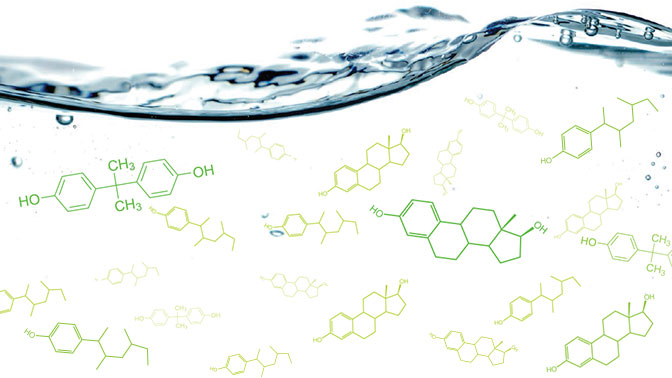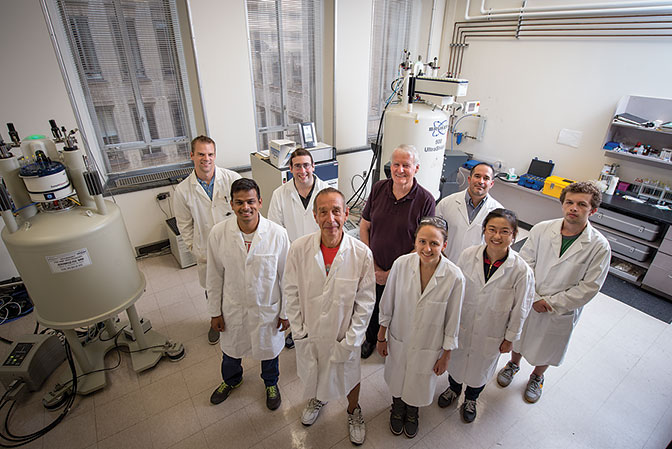

Troubled Waters
Cocktails of micropollutants are found in wastewater, lakes and streams, and drinking water. Carnegie Mellon’s Terry Collins has a clean-up solution.
by Amy Pavlak Laird
Many of us probably don’t give much thought to what we send down the drain. Where does the fancy foaming cleanser we use to wash our faces go? Or the weed killers applied to our lawns and gardens? What happens when we flush the toilet or have run-off after a storm? It all goes down the drain, ending up in wastewater treatment plants. “The products we use in our homes, the medications we take, the chemicals we spray on crops—every chemical we use—it all ends up in our water at some point,” said Terry Collins, the Teresa Heinz Professor of Green Chemistry at Carnegie Mellon.
Many pharmaceuticals, personal care products and household chemicals, not to mention industrial chemicals and pesticides, are “micropollutants”—compounds that produce adverse effects at low doses. These persistent contaminants show up in unexpected places. Human urine contains more than 3,000 compounds, 2,000 of which come from our diets, the drugs we take and the personal care products we use—many were not in the urine of our great-grandparents. Micropollutants cannot be fully eliminated with traditional wastewater treatment methods and wind up getting discharged into local waterways. Some end up returning to us in our drinking water.
Over the last few decades, micropollutants in our water have become an issue of increasing concern worldwide. In 2008, the Associated Press reported that pharmaceutical residues were found in the drinking water of 24 major metropolitan areas across the United States. The U.S. Geological Survey reported in 2000 that 80 percent of the 139 streams it sampled were found to have organic wastewater contaminants and pharmaceuticals, including antibiotics and reproductive hormones. In 2016, the EPA reported that atrazine, the second most widely used weed killer in the United States, which often ends up in surface and groundwater, poses chronic health risks to mammals, fish and birds.
Although the concentrations of micropollutants in our water are low, even minute traces affect fish and amphibians. Ethinylestradiol, for example, an artificial estrogen found in widely-used birth control pills, can cause male fish to develop eggs in their testes. Feminized male fish have been discovered in 37 different species in lakes and rivers throughout the world. Perhaps even more worrisome, research on frogs has indicated that mixtures of micropollutants, even at low concentrations, may present environmental hazards that are far greater than those for each individual compound.
“Aquatic animals are indicators of what can happen when hormone control systems get hijacked by synthetic chemicals,” Collins added. “We need to get these micropollutants out of our water systems.”
Collins and an international team of water treatment scientists and engineers, endocrine disruption experts and membrane developers believe they have the solution.
Collins and his research team in the Institute for Green Science (IGS) in the Mellon College of Science have developed catalysts that, together with hydrogen peroxide, break down many of the most persistent micropollutants. After inventing the first family of catalysts in 1995, the IGS refined them to be effective, affordable, remarkably versatile and easy to use.

From left: Matthew Mills, Yogesh Somasundar, Paul Kornbluh, Aleksandr Ryabov, Terry Collins, Genoa Warner, Matthew DeNardo, Liang Tang and Samuel Joyce-Farley
Collectively called TAML activators, the catalysts are small molecules that mimic oxidizing enzymes that living things, from bacteria to humans, use as their most potent detoxification strategy. TAMLs react with hydrogen peroxide to degrade persistent micropollutants, including ethinylestradiol, statins, antidepressants, beta-blockers, and NSAID pain relievers.
After creating the catalysts, Collins was quick to realize their promise. “We were taking pollutants that last in the environment for decades and decomposing them catalytically in minutes under ambient conditions,” he said. “Very early on, it became crystal clear to me that TAMLs might provide a revolutionary advancement in purifying water that could also provide an answer to micropollutants.”
Passing the Green Chemistry Safety Test
“TAML activators are so effective at degrading micropollutants, the only thing that worries me is their potential toxicity,” said Collins, an international leader in green chemistry—the design of chemical products and processes that reduce or eliminate the generation of hazardous substances.
To this end, one of green chemistry’s key themes is to produce technologies comprised of the same elements nature uses to build all living things. Even though Collins designed TAMLs so that they contain only biochemically common elements, it is still not possible to predict toxicity. Empirical evidence is necessary.
“Before TAML activators could be commercialized for decontaminating water, we needed to be sure that the TAMLs themselves, and their degradation products, weren’t endocrine disruptors.”
An important public health and environmental concern, endocrine disrupters are synthetic molecules that can mimic and interfere with the function of hormones in the body. A wide range of substances can cause endocrine disruption, including pharmaceuticals, dioxin and dioxin-like compounds, DDT and other pesticides, and plasticizers such as bisphenol A. Endocrine disruption can cause the feminization of fish and other intersex conditions in aquatic species like alligators, turtles and frogs. According to the National Institute of Environmental Health Sciences, some research suggests that these substances are also adversely affecting human health, resulting in reduced fertility and increased incidences or progression of some diseases, including obesity, diabetes, endometriosis and some cancers.
Several years ago, CMU Adjunct Chemistry Professor Pete Myers brought together leaders in endocrine disruption science and green chemistry to develop a testing system that shows scientists how to determine whether a new chemical has any endocrine disrupting activity. Called the Tiered Protocol for Endocrine Disruption (TiPED), the system consists of five tiers of assays that capture the presence of endocrine-related effects (see figure above). So far, multiple TAML safety studies in fish and a test in mice have shown no developmental or adult toxicity. Interestingly, in zebrafish embryo development assays on seven TAML activators, one TAML was found to be quite toxic. Collins eliminated it from water-treatment contention. The toxicity difference between this TAML and others could not be predicted from first principles. “There is simply no way to achieve this design-relevant insight without performing the empirical TiPED assays,” Collins asserted.

TiPED helps chemists determine the potential endocrine disrupting activity of a new chemical. The tiers are organized from the simplest and least expensive screens (left) to a whole animal lifetime assessment (right). The lower three tiers detect when chemicals can disturb the normal function of nuclear receptor proteins that the hormones activate to cause gene expression at single-cell levels or in the computer. In the final two tiers, chemical impacts on the full suite of endocrine hormone biochemistry are being assessed simultaneously either in adults, developing organisms, or across multiple generations.
Ridding Wastewater of Micropollutants
In the last several years, Collins has let TAMLs loose on endocrine-disrupting chemicals, most notably estrogenic compounds in water as these represent some of the most serious threats to the health of aquatic creatures. Collins teamed up with Brunel University London’s Susan Jobling and Rak Kanda, who are world-class experts in aquatic toxicity and wastewater treatment, to test the efficacy and safety of using TAML activators to degrade 17-α-ethinylestradiol (EE2), a synthetic estrogen found in oral contraceptives and a major cause of fish feminization. The research team showed that TAMLs were able to degrade not only EE2 in pure water, but also the early intermediate compounds created as TAMLs degraded EE2, which were also found to be estrogenic.
While the lab results were exciting, Collins was eager to see what TAMLs could do with actual wastewater. The research group took samples of water processed by a municipal wastewater plant in London—water that is known to contain numerous micropollutants like drugs and pesticides—and zeroed in on eleven compounds of high concern to the water treatment industry. The researchers found that TAMLs broke down not only the EE2 but also other estrogenic compounds and various micropollutants in the water.
Through all of these studies, it became clear to Collins that he and his colleagues were inventing a new field of chemistry—catalysis under ultradilute conditions in which the targets are present in vanishingly small concentrations. Currently, one kilogram of TAML catalysts can effectively treat tens of thousands of tons of wastewater in minutes. In 2015, the IGS created a second family of catalysts, “new-TAMLs,” that are far more potent than the original “old-TAMLs,” making them even more effective and reducing overall cost of scale up.
Competitive Advantages
The safety of the TAML process to date and its proven effectiveness for removing numerous micropollutants from wastewater make it a potentially transformative technology for advanced wastewater treatment. Preliminary studies show that the old-TAML processes are comparable to favored advanced treatment options, such as ozone or activated carbon, but at a much lower cost needed for wide use and potential commercialization. In Switzerland new legislation requires wastewater treatment plants to implement an additional treatment process specifically for the removal of micropollutants. The country is currently adding final-stage ozone or activated carbon processes to about 100 of its 700 municipal wastewater treatment plants at a cost of about $1 billion. This price tag is a hindrance to municipalities and countries around the world that would like to implement such changes to their wastewater treatment systems. According to Brunel’s Rak Kanda, “old-TAML plants are estimated to be 3–5 times lower in operating costs, significantly lower in capital costs and 2–3 times lower in energy use compared to ozone plants.” Because the new-TAMLs are so much more effective than old-TAMLs, the processes will cost even less; estimates are 10 percent of the cost of ozone treatment.
“When you combine the technical aspects, cost and environmental performances, we now have much better catalysts. And the data are unambiguous,” Collins said. “Our innovation provides an effective, affordable, versatile and safe solution for removing micropollutants from water.”